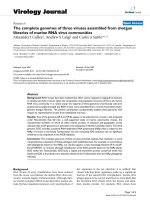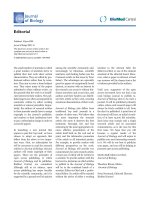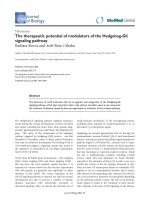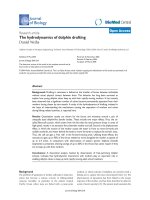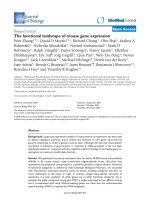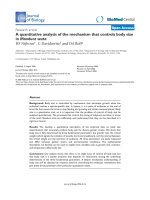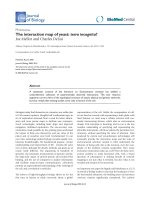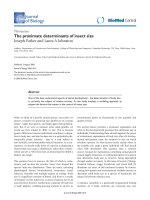Báo cáo sinh học: "The electronic version of this article is the complete" pptx
Bạn đang xem bản rút gọn của tài liệu. Xem và tải ngay bản đầy đủ của tài liệu tại đây (37.38 KB, 1 trang )
The year 2003 was a historic one for
the Open Access movement. It saw the
debut of Public Library of Science as a
publisher, with the much-heralded
launch of PLoS Biology, and declara-
tions of support from funding bodies
in numerous countries around the
world. In the United Kingdom, the
charitable Wellcome Trust joined the
funding council for universities and
the National Health Service in making
a commitment to support and
promote Open Access for the research
it sponsors. Similarly, elsewhere in
Europe, the Max-Planck Society led the
way and was joined by most major
funders of research in Germany, France
and beyond in signing the ‘Berlin Dec-
laration’ on Open Access.
The last year also saw increasing
numbers of authors voting — in the
way that counts, with the submission
of their precious research articles — to
support Open Access. BioMed Central,
the publisher of Journal of Biology, now
publishes more than 100 Open Access
journals, and to date these have con-
sidered more than 8,000 articles and
published more than 4,000. But differ-
ent journals within the BioMed
Central stable have different editorial
policies and standards. Journal of
Biology, which completed its first full
year of publication in 2003, was the
first fully Open Access journal publish-
ing articles of exceptional interest and
importance from the full spectrum of
biology; since launch it has received
over 250 submissions and has
accepted fewer than 5% of them for
publication. We are committed to
ensuring that Journal of Biology is a
prestigious place to publish, and this
means exercising a high degree of
selectivity in deciding what is pub-
lished in the journal.
Some readers and potential authors
have asked whether the journal isn’t
rather too selective, and why it doesn’t
simply publish more articles, even if
some must be of a lower standard.
One answer to this question is that we
are convinced that the best way to
ensure the optimum respect, visibility
and status for the articles we do
publish is to ensure that all of them
reach the highest possible standards of
science, significance and interest level,
rather than publishing some that fall
below this threshold. In assessing arti-
cles in this way, we are indebted to the
unflagging aid of anonymous peer-
reviewers as well as advisors such as
those on our Editorial Board. And in
bringing the significance of each pub-
lished article to the attention of a wide
readership, the work of the profes-
sional writers and scientists who have
provided the accompanying Research
news and Minireviews is similarly
invaluable.
A second answer to the question of
why Journal of Biology has not pub-
lished more articles is a pragmatic one.
Despite the dramatically increasing
awareness of the importance of Open
Access to the research community,
there is still work to be done in per-
suading individual authors that if their
research is published in a new journal
it will be accorded as much kudos, and
it will be as beneficial for their career,
as if it appears in one of the older,
more established titles that do not
provide Open Access. With each new
important article that appears under
Open Access, however, we move a step
nearer to this goal.
A final question that we are often
asked is whether there is some subset
of biological disciplines that this
journal views with particular interest.
The short answer is no. The articles
published to date in Journal of Biology
cover a broad range of biology — from
cell biology and microbiology to evo-
lution and genomics, and from bioin-
formatics to cell signalling and
development. If we have not yet
covered a particular area of biology, it
is because we have not yet received an
article of a sufficient standard in that
field. We trust that the articles to be
published over the coming months
will reassure readers and potential
authors that the aim implicit in the
journal’s name is being met, as we do
indeed plan to cover all of biology.
And finally, we have a question for
all readers of this article. Will 2004 be
the year you join the revolution in sci-
entific publishing and submit your
next exciting piece of research to the
journal?
Theodora Bloom, Editor, Journal of Biology
E-mail:
BioMed Central
Journal
of Biology
Editorial
Published: 16 January 2004
Journal of Biology 2004, 3:1
The electronic version of this article is the
complete one and can be found online at
/>© 2004 BioMed Central Ltd
Journal of Biology 2004, 3:1
